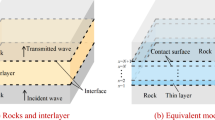Abstract
An element-free Galerkin method (EFGM) is used to solve the two-dimensional (2D) ground penetrating radar (GPR) modelling problems, due to its simple pre-processing, the absence of elements and high accuracy. Different from element-based numerical methods, this approach makes nodes free from the elemental restraint and avoids the explicit mesh discretization. First, we derived the boundary value problem for the 2D GPR simulation problems. Second, a penalty function approach and a boundary condition truncated method were used to enforce the essential and the absorbing boundary conditions, respectively. A three-layered GPR model was used to verify our element-free approach. The numerical solutions show that our solutions have an excellent agreement with solutions of a finite element method (FEM). Then, we used the EFGM to simulate one more complex model to show its capability and limitations. Simulation results show that one obvious advantage of EFGM is the absence of element mesh, which makes the method very flexible. Due to the use of MLS fitting, a key feature of EFM, is that both the dependent variable and its gradient are continuous and have high precision.
Similar content being viewed by others
References
LI Jing, ZENG Zhao-fa, HUANG Ling, LIU Feng-shan. GPR simulation based on complex frequency shifted recursive integration PML boundary of 3D high order FDTD [J]. Computers & Geosciences, 2012, 49: 121–130.
FENG De-shan, CHEN Cheng-shen, WANG Hong-hua. Finite element method GPR forward simulation based on mixed boundary condition [J]. Chinese J Geophys, 2012, 55(11): 3774–3785. (in Chinese)
LU Tiao, CAI Wei, ZHANG Ping-wen. Discontinuous galerkin time-domain method for GPR simulation in dispersive media [J]. IEEE Transactions on Geoscience and Remote Sensing, 2005, 43(1): 72–80.
FANG Hong-yuan, LIN Gao. Symplectic partitioned Runge-Kutta methods for two-dimensional numerical model of ground penetrating radar [J]. Computers & Geosciences, 2012, 49: 323–329.
LI Zhang-hui, HUANG Qin-hua, WANG Yan-bin. 2009. A 3-D staggered grid PSTD method for borehole radar simulations in dispersive media [J]. Chinese J Geophys, 52(7): 1915–1922. (in Chinese)
IRVING J, KNIGHT R. Numerical modeling of ground-penetrating radar in 2-D using MATLAB [J]. Computers & Geosciences, 2006, 32(9): 1247–1258.
FENG De-shan, DAI Qian-wei. GPR numerical simulation of full wave field based on UPML boundary condition of ADI-FDTD [J]. NDT&E International, 2011, 44(6): 495–504.
SHAARI A, AHMAD R S, CHEW T H. Effects of antenna-target polarization and target-medium dielectric contrast on GPR signal from non-metal pipes using FDTD simulation [J]. NDT & E International, 2010, 43(5): 403–408.
DI Qing-yun, WANG Miao-yue. Migration of ground-penetrating radar data with a finite-element method that considers attenuation and dispersion [J]. Geophysics, 2003, 69: 472–477.
BELYSCHKO T, LU Y Y, GU L. Element-free Galerkin methods [J]. International Journal for Numerical Methods in Engineer, 1994, 37: 229–256.
CINGOSKI V, MIYAMOTO N, YAMASHITA H. Hybrid element-free Galerkin-free Galerkin-finite element method for electromagnetic field computations [J]. IEEE Trans on Magnetics, 2000, 36(4): 1543–1547.
HO S L, YANG S, MACHADO J M, WONG H C. Application of a meshless method in electromagnetic [J]. IEEE Trans on Magnetics, 2001, 37(5): 3198–3202.
BRIGHENTI R. Application of the element-free Galerkin meshless method to 3-D fracture mechanics problems [J]. Engineering Fracture Mechanics, 2005, 72(18): 2808–2820.
ZHANG Z, LIEW K M, CHENG Y M, LEE Y Y. Analyzing 2D fracture problems with the improved element-free Galerkin method [J]. Engineering Analysis with Boundary Elements, 2008, 32(3): 241–250.
JIA Xiao-feng, HU Tian-yue. Element-free precise integration method and its applications in seismic modelling and imaging [J]. Geophys J Int, 2006, 166(1): 349–372.
KATOU M, MATSUOKA T, MIKADA H, SANADA Y, ASHIDA Y. Decomposed element-free Galerkin method compared with finite-difference method for elastic wave propagation [J]. Geophysics, 2009, 74(3): H13–H25.
LANCASTER P, SALKAUSKAS K. Surface generated by moving least squares methods [J]. Math Comput, 1981, 37(155): 141–158.
LIU Su-zhen, YANG Qing-xin, CHEN Hai-yan, XU Gui-zhi, LIU Fu-gui. Improvement of the element-free Galerkin method for electromagnetic field calculation [J]. IEEE Transactions on applied superconductivity, 2004, 14(2): 1866–1869.
VENTURA G. An augmented Lagrangian approach to essential boundary conditions in meshless methods [J]. Int J Num Mech Engrg, 2002, 53(4): 825–842.
BELYTSCHKO T, ORGAN D, KRONGAUZ Y. A coupled finite element-element-free Galerkin method [J]. Computational Mech, 1995, 17(3): 186–195.
GAVETE L, BENITO J J, FALCON S, RUIZ A. Penaly functions in constrain variational principles for element free Galerkin method [J]. European Journal of Mechanics-A/Solids, 2000, 19(4): 699–720.
CLAERBOUT J F. Imaging the Earth’s interior [M]. Oxford: Blackwell Scientific Publications, 1985.
Author information
Authors and Affiliations
Corresponding author
Additional information
Foundation item: Project(41074085) supported by the National Natural Science Foundation of China; Project(NCET-12-0551) supported by the Funds for New Century Excellent Talents in University, China; Project supported by Shenghua Yuying Program of Central South University, China
Rights and permissions
About this article
Cite this article
Feng, Ds., Guo, Rw. & Wang, Hh. An element-free Galerkin method for ground penetrating radar numerical simulation. J. Cent. South Univ. 22, 261–269 (2015). https://doi.org/10.1007/s11771-015-2517-7
Received:
Accepted:
Published:
Issue Date:
DOI: https://doi.org/10.1007/s11771-015-2517-7




